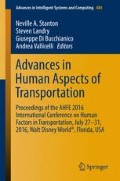Abstract
Advancements of in-vehicle technologies and the development of mobile applications that keep a driver connected in a driving environment have caused an increasingly dangerous safety concern. Distracted driving has gained the attention of legislators and governments globally. Countries have constituted bans that partially or fully forbid drivers from using gadgets while driving, especially hindering out-of-the-vehicle communications. This paper introduces Voiceing™, a voice-activated application meant to improve social communications in the car, serving as a safe alternative to distracted driving. Other modalities of interaction such as texting, in-vehicle conversations and outside-of-the-vehicle conversation have been measured and compared with Voiceing™ investigating effects on driver’s performance, cognitive load and user acceptance. Results from this study suggest that Voiceing™ is a safer alternative than in-vehicle interactions with humans. Results also show that natural speech interaction of in-vehicle applications and the inclusion of context awareness help improve driving performance while interacting with a vehicle system.
Access this chapter
Tax calculation will be finalised at checkout
Purchases are for personal use only
References
Dimmick, J., Feaster, J.C., Ramirez, A.: The niches of interpersonal media: relationships in time and space. New Media Soc. 13(8), 1265–1282 (2011)
Sohn, T., et al.: A diary study of mobile information needs in computer-human interactions CHI’08 (2008)
Bruyas, M., et al.: Does making a conversation asynchronous reduce the negative impact of phone call on driving? French National Institute for Transport and Safety Research (2008)
Alm, H., Nilsson, L.: The effects of a mobile telephone task on driver behaviour in a car following situation. Accid. Anal. Prev. 27(5), 707–715 (1995)
Horrey, W.J., Lesch, M.F., Garabet, A.: Assessing the awareness of performance decrements in distracted drivers. Accid. Anal. Prev. 40(2), 675–682 (2008)
Ranney, T.A., Harbluk, J.L., Noy, Y.: Effects of voice technology on test track driving performance: implications for driver distractions. Hum. Factors J. Hum. Factors Ergon. Soc. 47(2), 439–454 (2005)
McKnight, A.J., McKnight, A.S.: The effect of cellular phone use upon driver attention. Accid. Anal. Prev. 25(3), 259–265 (1993)
Lee, J.D., Regan, M.A., Young, K.L.: Defining driver distraction. CRC Press, Boca Raton FL (2008)
Stutts, J.C.: The role of driver distraction in traffic crashes. AAA Foundation for Traffic Safety, Washington DC (2001)
FCC: Texting while driving guidelines. http://www.fcc.gov/guides/texting-while-driving
Scherer, K.R.: Vocal markers of emotion: comparing induction and acting elicitation. Comput. Speech Lang. (2011)
Roesch, E., Bänziger, T., Scherer, K.: Preliminary plans for exemplars: theory. Hum. Netw. Excelence (2004)
Pitterman, J., Pitterman, A., Minker, W.: Handling emotions in human-computer dialogues. Springer, Ulm, Germany (2010)
Merriam Webster Online Dictionary. http://www.merriam-webster.com/dictionary/emotion
Goselin, P.A., Gagné, J.: Use of a dual-task paradigm for measure listening effort. Can. J. Speech Lang. Pathol. Audiol. 3(2), 159–177 (2010)
Eyben, F., et al.: Emotion on the road; necessity, acceptance, and feasibility of affective computing in the car. Adv. Hum Comput. Interac. (2010)
Scherer, K.R.: Psychological models of emotion. In: Borod, J.C. (ed.) The Neuropsychology of Emotion, pp. 137–162. Oxford University Press, New York (2000)
Jeon, M., et al.: Enhanced auditory menu cues improve dual task performance and are preferred with in-vehicle technologies. In: Proceedings of the First International Conference on Automotive User Interfaces and Interactive Vehicular Applications, ACM, Essen, Germany. pp. 91–98 (2009)
Scherer, K.R.: Vocal markers of emotion: comparing induction and acting elicitation. Comput. Speech Lang. (2011)
Plutchik, R.: The nature of emotions. Am. Sci. 89, 344–350 (2001)
Venkatesh, V., et al.: User acceptance of information technology: towards a unified view. MIS Quaterly 27(3), 425–478 (2003)
McDonald, R., et al.: Structured models for fine-to-coarse sentiment analysis. In: 45th Annual Meeting of the Association of Computational Linguistics. Association of Computational Linguistics, Prague, Czech Republic (2007)
Picard, R.W.: Affective Computing. MIT Press, Cambridge, MA (1997)
Author information
Authors and Affiliations
Corresponding author
Editor information
Editors and Affiliations
Rights and permissions
Copyright information
© 2017 Springer International Publishing Switzerland
About this paper
Cite this paper
Alnizami, H., Alvarez, I., Gilbert, J.E. (2017). Socializing Under the Influence of Distracted Driving: A Study of the Effects of in-Vehicle and Outside-of-the-Vehicle Communication While Driving. In: Stanton, N., Landry, S., Di Bucchianico, G., Vallicelli, A. (eds) Advances in Human Aspects of Transportation. Advances in Intelligent Systems and Computing, vol 484. Springer, Cham. https://doi.org/10.1007/978-3-319-41682-3_21
Download citation
DOI: https://doi.org/10.1007/978-3-319-41682-3_21
Published:
Publisher Name: Springer, Cham
Print ISBN: 978-3-319-41681-6
Online ISBN: 978-3-319-41682-3
eBook Packages: EngineeringEngineering (R0)

